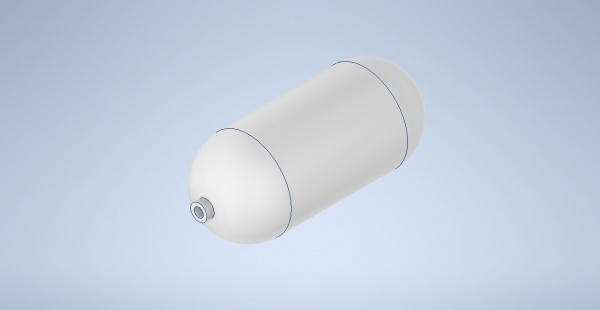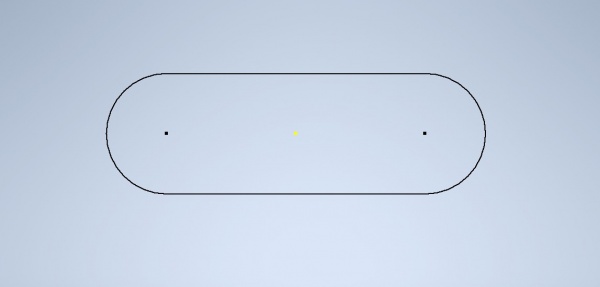Final Report of Hydrogen Storage Optimization Project, Darell Jeremia Sitompul, 6 Juni 2023
Requirement:
- Capacity = 1 Liter
- Budget = Rp.500.000,00 (Lima ratus ribu rupiah)
First of all, to start doing the calculation, I would like to imagine the ideal shape for a hydrogen storage. My assumption would be a form of a capsule.
Here is the visualization model (Made with Autodesk Inventor Professional 2022).
And the cross section 2 dimensional view from the centerline will look like this.
We need to optimize the storage surface area to a minimum and keep the volume at 1 liter. The storage space volume is fixed at 1 liter, but there are many combinations of radius and flat tube height. We can use programming to help us save alot of calculation time.
Finding Smallest Surface Area of the capsule with radius from 0 to 20 centimeters
Here is the code:
import numpy as np
print(": Radius : Surface Area :")
r_max = 20
a = np.zeros((r_max, 2))
for r in range (1, r_max + 1):
flat_tube_height = (1000-((4*np.pi*r**3)/3))/(np.pi*(r)**2)
sur_area = ((2*np.pi*r) * flat_tube_height) + ((2*np.pi*r**2)*2)
a[r-1][0] = int(r)
a[r-1][1] = np.round(sur_area, 5)
print(": ", a[r-1][0], " "*(6 - len(str(a[r-1][0]))),
" : ", a[r-1][1], " "*(12 - len(str(a[r-1][1]))), " :")
b = a
for i in range(len(b)):
for j in range (len(b)):
if b[i][1] < b[j][1]:
for n in range (2):
temp = b[i][n]
b[i][n] = b[j][n]
b[j][n] = temp
print("Minimum surface area will be found when")
print("Radius = ", b[0][0])
print("Surface Area : ", b[0][1])
When we run the program, the result will be shown like this
: Radius : Surface Area : : 1.0 : 2004.18879 : : 2.0 : 1016.75516 : : 3.0 : 704.36578 : : 4.0 : 567.02064 : : 5.0 : 504.71976 : : 6.0 : 484.12978 : : 7.0 : 490.96501 : : 8.0 : 518.08257 : : 9.0 : 561.51423 : : 10.0 : 618.87902 : : 11.0 : 688.6618 : : 12.0 : 769.85246 : : 13.0 : 861.7517 : : 14.0 : 963.86002 : : 15.0 : 1075.81113 : : 16.0 : 1197.33029 : : 17.0 : 1328.20743 : : 18.0 : 1468.27914 : : 19.0 : 1617.41642 : : 20.0 : 1775.51608 : Minimum surface area will be found when Radius = 6.0 Surface Area : 484.12978
We see that there is a decrease and increase in the value of the capsule area from radius 5 cm to 6 cm and from radius 6 cm to 7 cm respectively. We can find more precise result of the minimum surface area by reducing the radius range only from 5 cm to 7 cm.
We can use smaller difference of radius within iterations than the first program from 1 cm difference by each iterations to 10^(-5) cm difference.
Here is the code:
import numpy as np
a = []
r = 5
while True:
flat_tube_height = (1000-((4*np.pi*r**3)/3))/(np.pi*(r)**2)
sur_area = ((2*np.pi*r) * flat_tube_height) + ((2*np.pi*r**2)*2)
a.append((sur_area, r))
r += 1e-5
if r > 7:
break
print(min(a))
When we run the program, the result is being shown like below:
(483.5975862052437, 6.203499999954438)
The numerically minimum surface area can be obtained when the radius is about 6.20349 cm and the value of numerically minimum surface area is about 483.59758 cm^2.
Now we need to find the thickness of our material so that the storage could withstand the pressure of the hydrogen inside.
The material chosen is Aluminum 6061-T6 that has yield strength equal to 276 MPa.
Let's calculate theoretical hoop stress of the required hydrogen gas pressure using Python program.
import numpy as np
print(": Thickness (mm) : Hoop Stress (MPa) :")
r = 6.20349e-2
p = 0.8
t = 1
mylist = []
while t < 14:
hoop_stress = (r * p * 1000)/(t)
mylist.append((t, hoop_stress))
print(": ", mylist[t-1][0], " "*(6 - len(str(mylist[t-1][0]))),
" : ", np.round(mylist[t-1][1],5), " "*(11 - len(str(np.round(mylist[t-1][1],5)))), " :")
t += 1
And we get the following result
: Thickness (mm) : Hoop Stress (MPa) : : 1 : 49.62792 : : 2 : 24.81396 : : 3 : 16.54264 : : 4 : 12.40698 : : 5 : 9.92558 : : 6 : 8.27132 : : 7 : 7.0897 : : 8 : 6.20349 : : 9 : 5.51421 : : 10 : 4.96279 : : 11 : 4.51163 : : 12 : 4.13566 : : 13 : 3.81753 :
We see that the thinnest option of the coding (in this case, 1 mm) has hoop stress almost 50 MPa (barely more than a fifth of our material Yield Strength).
If we modify the formula of Hoop stress to get the thickness so that the hoop stress approaches 276 MPa, we get the thickness is about 0.0001798113 mm. But in industrial level, there is no such Aluminum 6061 with that thickness being mass produced.
That means we should see the available option from which thickness are available on the market.
Note that there are many available options in the market, but not every options are suitable to our requirements. The example is the 16 mm thickness option if we calculated it into out required surface area, the cost exceeds Rp500.000,00 (The maximum budget).
Therefore, we have 5 option that costs below Rp500.000,00. But we need to eliminate some options based on price. Since option 5 mm and 8 mm thickness are relatively cheaper than the other, we can choose either 5 mm thickness or 8 mm thickness.
Even if 5 mm and 8 mm thickness are cost-effective, we choose the option that can withstand greater stress and have bigger safety factor. Therefore, we prefer 8 mm thickness option for our Hydrogen Storage Tank.


